Arena Cheturshogqi
Arena Cheturshogqi is a large chess variant for two to four players. It is primarily influenced by Shatranj, Chaturanga for Four Players, Chess, Xiangqi and Shogi, though chess variant fans will most definitely see there are other influences as well. It is my attempt at an amalgamation of inspirations from some of my favorite historical and newer chess variants to produce a new and challenging variation that will be both an homage to its various (and varied) predecessors as well as an enjoyable and challenging game in its own right. The result is a fast-paced, unprecictably evolving battle that is never the same twice, but is always a lot of fun! Get ready for a wild ride: Once you enter the Arena, there is no turning back!
Setup
Two player Arena Cheturshogqi is played on an 11 x 11 square board. There are two Keeps which are three squares by three squares (3 x 3) on the center of each player’s side of the board. With the exception of the Keeps, the board is checkered with the corners being black. The keeps are solid grey to distinguish them from the rest of the board. The five square by five square (5 x 5) area that is in the middle, between the two Keeps (and outlined in red), is The Arena.

Three or four player Arena Cheturshogqi is played on a 13 x 13 square board. There are four Keeps which are three squares by three squares (3 x 3) on the center of each of the four sides of the board. With the exception of the four Keeps, the board is checkered with the corners being white. The keeps are solid grey to distinguish them from the rest of the board. The seven square by seven square (7 x 7) area that is in the middle, between the four Keeps (and outlined in red), is the Arena.
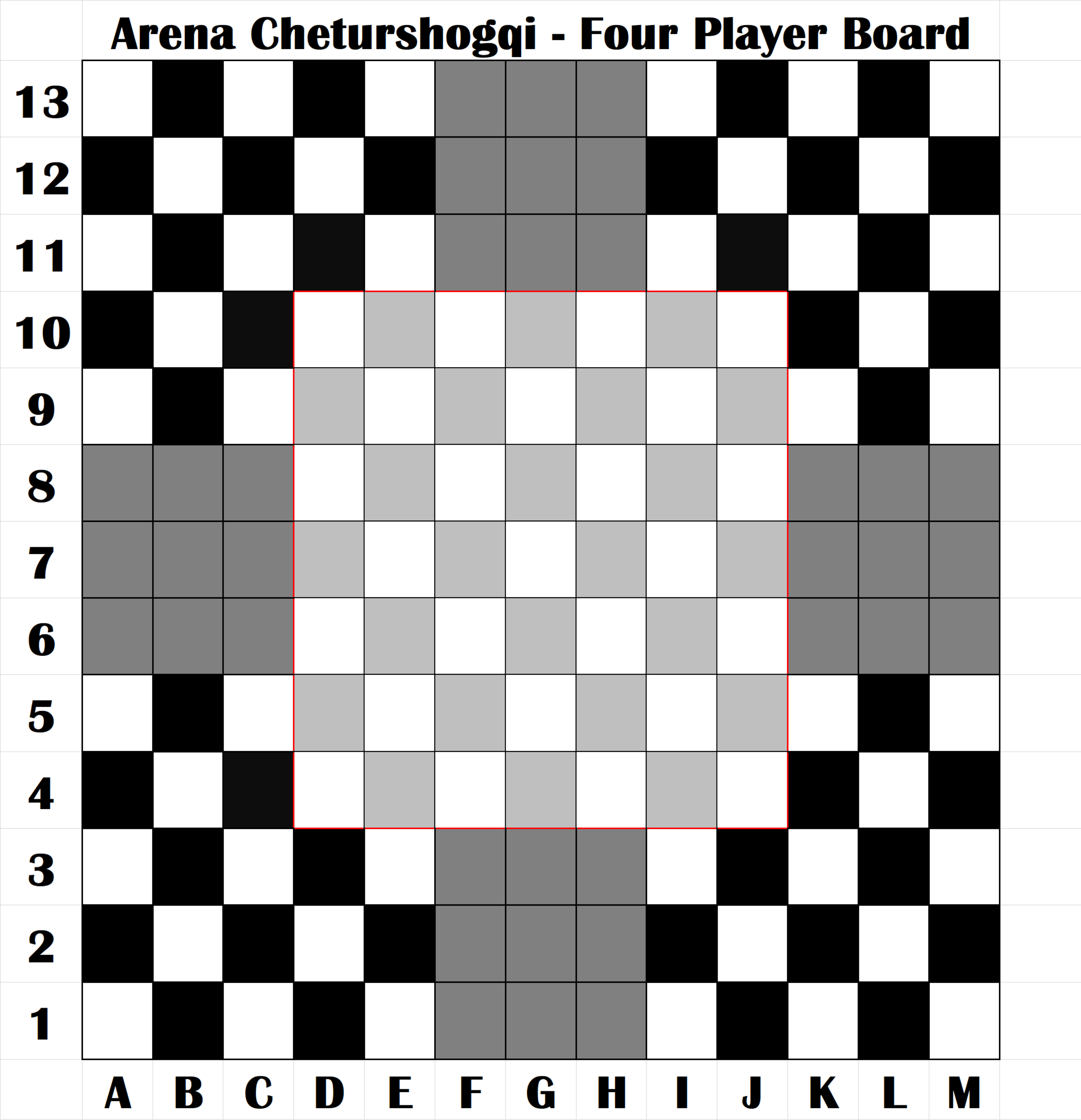
The pieces are all non-colored Shogi-like pieces with a pointed end indicating the direction that they are facing, which is to indicate whose pieces they are as well as to orient their movement. (As in Shogi, all of a player’s pieces will always point away from the player to whom they belong.) Each player begins the game with the following set of pieces on the board: A King, a Queen, a Knight, a Rook, a Bishop, a Ferz, an Elephant, a Wazir and a Dabbabah, all of which are placed in their Keep, and three Pawns that are placed in the Arena on the three squares immediately in front of their player’s Keep. Each player places their nine starting non-Pawn pieces in their Keep in any way they wish, subject to the rules below. Each player also has the following pieces in their off-board reserve at the beginning of the game: One Knight, one Rook, one Bishop, one Ferz, one Elephant, one Wazir and one Dabbabah.
Pieces
Basic Pieces:
Here are the pieces that all players begin the game with:
 King: One step in any direction to move or capture.
King: One step in any direction to move or capture.
 Queen: Unlimited clear orthogonals or diagonals to move or capture.
Queen: Unlimited clear orthogonals or diagonals to move or capture.
 Bishop: Unlimited clear diagonals to move or capture.
Bishop: Unlimited clear diagonals to move or capture.
 Rook: Unlimited clear orthogonals to move or to capture.
Rook: Unlimited clear orthogonals to move or to capture.
 Knight: 1,2 or 2,1 leaper to move or capture.
Knight: 1,2 or 2,1 leaper to move or capture.
 Pawn: One step forward to move (two on initial move), one step diagonally forward to capture.
Pawn: One step forward to move (two on initial move), one step diagonally forward to capture.
 Ferz: One step diagonally to move or capture.
Ferz: One step diagonally to move or capture.
 Elephant: Leaps two spaces diagonally to move or to capture.
Elephant: Leaps two spaces diagonally to move or to capture.
 Wazir: One step orthogonally to move or to capture.
Wazir: One step orthogonally to move or to capture.
 Dabbabah: Leaps two spaces orthogonally to move or to capture.
Dabbabah: Leaps two spaces orthogonally to move or to capture.
"Mutated" (Compound) Pieces:
All of the pieces below are possible "mutated" pieces that can be made by captures in the Arena. Except where the compound piece has a well-known and recognized name, they are simply identified by the two pieces that are compounded to make them.
In the movement diagrams below a square is a non-jumping move, a circle is a jumping move. If a space can be reached by both a jumping and a non-jumping move, this is indicated by a square inside a circle. If the move may result in a capture it will have an X in it. If you can only move to the space but cannot capture there, the square or circle will not have an X in it.
 Amazon: Compound of a Queen and a Knight.
Amazon: Compound of a Queen and a Knight.
 Cardinal: Compound of a Bishop and a Knight. (This piece is also known by several names, Archbishop being one of the most popular, along with Princess and Paladin.)
Cardinal: Compound of a Bishop and a Knight. (This piece is also known by several names, Archbishop being one of the most popular, along with Princess and Paladin.)
 Centaur: Compound of a King (or Man) and a Knight.
Centaur: Compound of a King (or Man) and a Knight.
 Dragon King (King): Compound of a King and a Rook.
Dragon King (King): Compound of a King and a Rook.
 Dragon King (Ferz): Compound of a Ferz and a Rook.
Dragon King (Ferz): Compound of a Ferz and a Rook.
 Man: Compound of a Ferz and a Wazir, a non-royal piece with the same movement and capture as a King.
Man: Compound of a Ferz and a Wazir, a non-royal piece with the same movement and capture as a King.
 Marshall: Compound of a Rook and a Knight.
Marshall: Compound of a Rook and a Knight.
 Bishop King:
Bishop King: 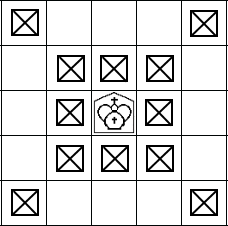
 Bishop Pawn:
Bishop Pawn: 
 Bishop Wazir:
Bishop Wazir: 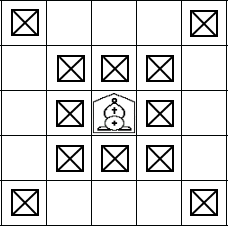 (This piece is listed in the piececlopedia as a Dragon Horse, the promoted form of a Bishop in Shogi.)
(This piece is listed in the piececlopedia as a Dragon Horse, the promoted form of a Bishop in Shogi.)
 Dabbabah Bishop:
Dabbabah Bishop: 
 Dabbabah Elephant:
Dabbabah Elephant: 
 Dabbabah Ferz:
Dabbabah Ferz: 
 Dabbabah King:
Dabbabah King: 
 Dabbabah Knight:
Dabbabah Knight:  (This piece is listed in the piececlopedia as a Carpenter.)
(This piece is listed in the piececlopedia as a Carpenter.)
 Dabbabah Pawn:
Dabbabah Pawn: 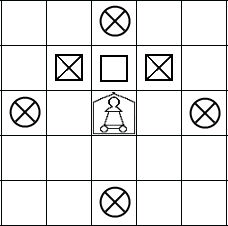
 Dabbabah Queen:
Dabbabah Queen: 
 Dabbabah Rook:
Dabbabah Rook: 
 Dabbabah Wazir:
Dabbabah Wazir: 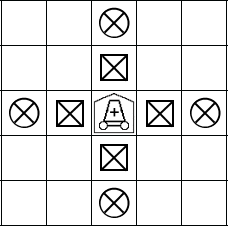
 Elephant Bishop:
Elephant Bishop: 
 Elephant King:
Elephant King: 
 Elephant Knight:
Elephant Knight: 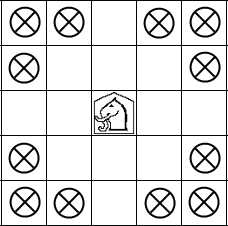 (This piece is also known as the Kangaroo (Newton) and was first used in a variant on the Chess Variant Pages in Timothy R. Newton's Outback Chess, the winner of the 84 Squares Contest.)
(This piece is also known as the Kangaroo (Newton) and was first used in a variant on the Chess Variant Pages in Timothy R. Newton's Outback Chess, the winner of the 84 Squares Contest.)
 Elephant Pawn:
Elephant Pawn: 
 Elephant Queen:
Elephant Queen: 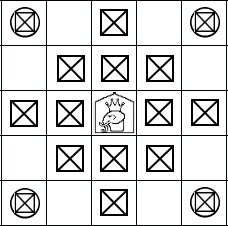
 Elephant Rook:
Elephant Rook: 
 Ferz Elephant:
Ferz Elephant: 
 Ferz Knight:
Ferz Knight: 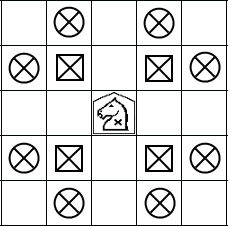
 Ferz Pawn:
Ferz Pawn: 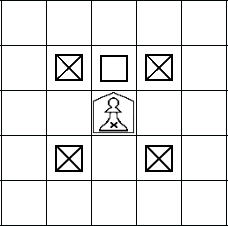
 Pawn Knight:
Pawn Knight: 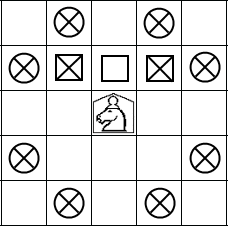 (This piece is listed in the piececlopedia as a Dragon.)
(This piece is listed in the piececlopedia as a Dragon.)
 Pawn Rook:
Pawn Rook: 
 Wazir Knight:
Wazir Knight: 
 Wazir Pawn:
Wazir Pawn:  (This piece is known as a Gold General in Shogi.)
(This piece is known as a Gold General in Shogi.)
 Wazir Elephant:
Wazir Elephant: 
Rules
Arena Cheturshogqi follows the normal rules of chess, except as noted below:
- Players randomly determine who will go first, then play proceeds clockwise.
- A King may never leave his Keep, all other pieces are allowed to come and go as they wish.
- Two Kings may never face each other on the same orthogonal without intervening pieces, to do so would be considered being in check. However, Kings may face each other on the same diagonal without intervening pieces without being considered to be in check.
- A King may never enter a space where he would be in check.
- As long as there are more than two Kings on the board, the Kings must be captured, not merely put in checkmate, but once the game is down to only two players, the first player to checkmate the opponent wins.
- When a player’s King is captured, all of that player’s pieces are immediately removed from play. They do NOT go into any player’s off-board reserve.
- Pawns may make an initial two-step move if they have not moved.
- There is no castling.
- There is no en-passant.
- There is no promotion, only mutation.
Each player gets to hold any pieces they capture outside of the Arena in their off-board reserve. On a subsequent turn the player may drop them back onto the board. Pieces may be dropped subject to the following conditions:
- Only one piece may be dropped on the board per turn, and this must be done instead of moving a piece that is already on the board.
- No piece may be dropped on a square from which it is impossible to move.
- A captured piece may be dropped only on an empty space that is not inside an enemy Keep.
- A Pawn may not be dropped onto a file containing another Pawn belonging to the same player.
- No piece may be dropped where it will cause check-mate. It may be dropped where it will cause check, but NOT checkmate.
- If a player has a mutated piece in reserve, they may drop the mutated piece or they may choose to un-mutate the piece and drop either of the pieces it was made of instead. If they choose to un-mutate the piece they are dropping, then they do not have the mutated piece in reserve any longer and they do not get the other constituent piece that made up the mutated piece in their reserve. One piece in, one piece out. (For example, if I have an Amazon in my reserve, I could drop the Amazon, a Queen or a Knight, but no matter which piece I choose to drop it as, I do not get any pieces back into my reserve.) Because the Bishop, Rook, King (or Man) and Queen are always treated as if they were a non-mutated piece for the purposes of mutation, they may not be un-mutated using this rule.
- Under the previous rule, if a player un-mutates a compound piece that was formed with a captured King and chooses to drop the King piece, it is a non-royal Man with the same movement and capture as a King.
The Arena is a very important area. As such, it has some special rules which we will consider here:
- From the very beginning of the game until the very end, every player is required to have at least one piece in the Arena at all times.
- If a player has their last piece in the Arena captured, then on their very next turn they MUST move or drop a piece into the Arena or they lose the game! This rule must be followed, even if they are in check!
- Inside the Arena any non-mutated piece that captures a non-mutated enemy piece which can make movements the capturing piece cannot already make immediately “mutates” and becomes a compound of the piece that made the capture and the piece it captured!
- When a piece has “mutated,” the new compound piece remains on the board in the place of the capturing piece and no piece is added to the capturing player’s reserve.
- Only non-mutated pieces may mutate.
- Because Bishops, Rooks, Kings (or Man pieces) and Queens are part of your starting army, they are always treated as if they are non-mutated for the purposes of mutation, even though they can be formed by mutation in the Arena. This means that there are four situations that will result in a “mutated” piece being considered non-mutated for the purposes of further mutation:
- If a Wazir captures a Rook in the Arena, then the Wazir mutates into a Rook and nothing is placed into the capturing player’s reserve.
- If a Ferz captures a Bishop in the Arena, then the Ferz mutates into a Bishop and nothing is placed into the capturing player’s reserve.
- If a Ferz captures a Wazir in the Arena (or vis versa), then the capturing piece mutates into a Man and nothing is placed into the capturing player's reserve.
- If a Rook captures a Bishop in the Arena (or vis versa) then the capturing piece mutates into a Queen and nothing is placed into the capturing player’s reserve.
Let’s consider a few examples to help make captures and mutation clear:
- A Knight captures a Rook in the Arena. The Knight is replaced immediately by a Marshall (which moves like either a Knight or a Rook) and no piece is placed in the player’s reserve. Had the same capture taken place anywhere outside of the Arena, the captor would simply have placed the Rook in their reserve.
- A Bishop captures a Ferz in the Arena. The captor simply places the captured Ferz in their reserve because the captured piece cannot make a move that the capturing piece cannot make.
- A mutated Pawn/Ferz captures a Queen in the Arena. The captured Queen is placed in the capturing player’s reserve. This is because even though the Queen can make moves that the Pawn/Ferz cannot make, only non-mutated pieces may mutate.
- A Queen formed by a Rook capturing a Bishop in the Arena later captures a piece in the Arena that can make moves the capturing Queen cannot make. The Queen will mutate just like the player’s original starting Queen would because Queens are always considered non-mutated for the purposes of mutation.
 This 'user submitted' page is a collaboration between the posting user and the Chess Variant Pages. Registered contributors to the Chess Variant Pages have the ability to post their own works, subject to review and editing by the Chess Variant Pages Editorial Staff.
This 'user submitted' page is a collaboration between the posting user and the Chess Variant Pages. Registered contributors to the Chess Variant Pages have the ability to post their own works, subject to review and editing by the Chess Variant Pages Editorial Staff.
By Paul E. Newton.
Last revised by Fergus Duniho.
Web page created: 2023-03-17. Web page last updated: 2023-03-19
